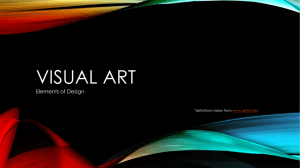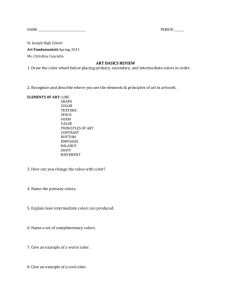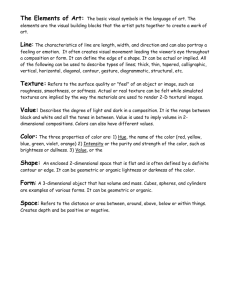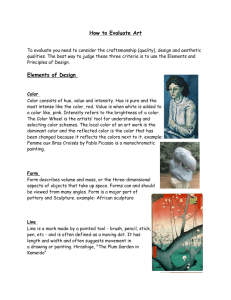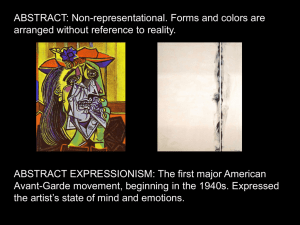2. Unit Two - Dr.Antar Abdellah Home Page
advertisement
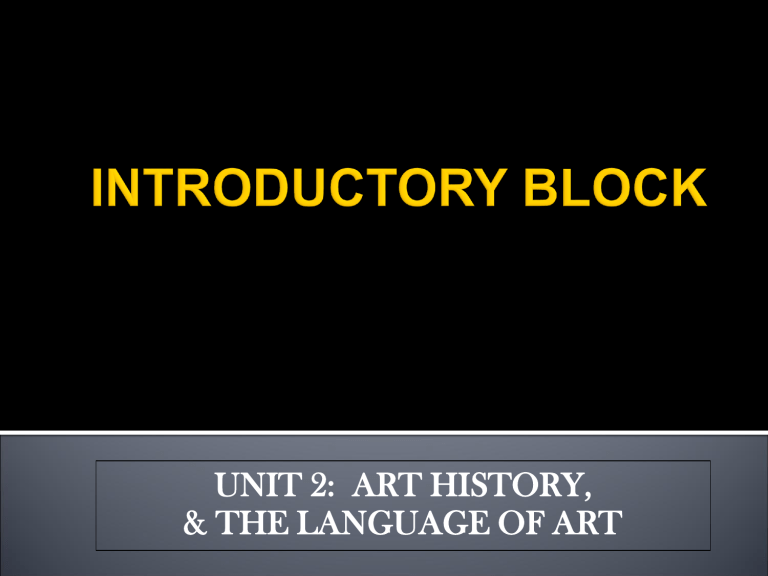
UNIT 2: ART HISTORY,
& THE LANGUAGE OF ART
•
•
•
•
•
•
Art has a great place in the culture and life of every civilization.
The historic arts are the basis of the existence of modern art forms
in the various parts of the world.
Learning historic arts is important in a better understanding about a
nation or a civilization.
People usually use verbal words and hand and facial gestures to
express themselves.
People also use visual means of communication, such as paintings
and drawings to express their feelings and points of view.
People use music as another serious means of communication and
self expressing.
ART HISTORY
•
•
•
•
The history of art usually refers to the history of the visual
arts, such as painting, sculpture, and architecture.
The term also encompasses (covers) theory of the visual
arts.
It is not usually taken or intended to refer to the performing
arts or literary arts.
The history of art attempts an objective survey of art
throughout human history, classifying cultures and
periods, and noting their distinguishing features and
influences.
ART HAS A
‘LANGUAGE’
•
•
A writer’s language depends on the use of verbal and
written words.
An artist’s language depends on the use of a visual
language or visual symbols, as opposed to verbal
symbols, or words such as lines, colors, and shapes.
The Elements of Art
•
•
•
The Elements Of Art are the building blocks of art
creation and the structure of the work, and they can
carry a wide variety of messages.
The Elements Of Art are the Visual Language of art,
and they can be analyzed, organized, and
manipulated by artists.
When looking at a work of art, see if you can
identify which Elements of Art the artist stressed,
organized or used to express a message or to
create a mood.
The Elements of Art II
The elements of art are nine components:
•
Color
•
Form and Shape
•
Movement
•
Pattern
•
Point and Line
•
Space
•
Texture
COLOR
•
•
•
•
•
Many people would argue that the Element of ‘Color’ has the most effect on
a work of art.
Consider what our world would look like if everything was black, white, and
shades of gray?
Artists have known that ‘Color’ has a powerful effect on their works and on
the impressions of the viewers.
Light reflects off objects creating seven main colors {Blue, Purple, Pink, Red,
Orange, Yellow, & Green}.
Color has three main characteristics:
hue (red, green, blue, etc.) value (how light or dark it is) intensity (how bright
or dull it is)
•
Colors can be described as warm (red, yellow) or cool (blue, gray),
depending on which end of the color spectrum (rainbow) they fall.
COLOR (Hue)
•
•
•
Hue is the term for the pure spectrum colors
commonly referred to by the ‘color names’ – blue,
purple, pink, red, orange, yellow, & green – which
appear in the hue circle or rainbow.
Theoretically, the primary colors consist of three
hues from which we can theoretically mix all other
hues.
When pigment primaries are all mixed together,
the theoretical result is black, which is sometimes
referred to as subtractive mixture.
•
COLOR
(Value)
Value is defined as the relative brightness (lightness or
of a color.
•
•
•
•
•
•
darkness)
It is an important tool for the artist, in the way it defines form and creates
spatial illusions.
Artists use color value to create different moods.
Dark colors in a composition suggest a lack of light, as in a night or
interior scene.
Dark colors can often convey a sense of mystery or foreboding (heavy
feelings).
Light colors often describe a light source or light reflected within the
composition.
Artists could use light colors to describe the light created by the candle
flame, the moonlight.
COLOR (Illusion)
•
•
Some of the effects of color occur only in the
eye and brain of the viewer, and are not
physical properties of light waves or pigment.
These illusions, however, are very powerful,
and have enormous impact on our responses
to color.
COLOR (Intensity)
•
•
•
•
Intensity refers to the purity, strength, or quantity
of a given hue or value used in color compositions.
In order to create emphasis, one should make a
clear decision as to which hue, value, and intensity
should be assigned.
Bright colors are undiluted (unmixed), and they are
often associated with positive energy and
heightened emotions.
Dull colors are diluted by mixing with other colors
and create a sedate or serious mood.
COLOR (Intensity II)
•
•
•
The color proportion choice will also affect the
impact of the color composition.
This can be seen in the set of panels, where the
very same colors are used in each panel.
Yet depending on the choice of dominant color,
the feeling of the composition, and even the
appearance of each color, is altered.
FORM & SHAPE
•
•
•
•
Form and shape are areas or masses which define
objects in space; indeed they cannot exist without
space.
There are various ways to categorize form and
shape since they can be thought of as either two
dimensional or three dimensional.
Two dimensional form has width and height.
Three dimensional shape has depth as well as
width and height.
FORM & SHAPE
•
•
•
Forms are often called the ‘three-dimensional
shapes’ because, unlike flat, two-dimensional
areas, forms are represented as ‘threedimensional’.
Shapes are everywhere, and the more common
ones are given names such as circle or square.
There are an infinite amount of shape possibilities
and combinations.
MOVEMENT
•
•
•
Movement is the process of relocation of
objects in space over time, and it can be
literal or compositional.
The physical movement of designed objects
is known as literal movement.
Another way to think about movement is to
consider how the viewer’s eye moves
through the composition.
MOVEMENT
•
•
•
This is what we refer to as compositional
movement.
In this case, we are not concerned with the
presence (or lack of) implied motion in the image.
We are concerned instead with how the viewer
perceives the composition, and how the
components relate and lead the viewer’s attention.
PATTERN
•
•
•
Pattern is a structure that organizes surfaces or
structures in a consistent, regular manner.
Pattern can be described as a repeating unit of
shape or form, but it can also be thought of as the
‘skeleton’ that organizes the parts of a
composition.
Pattern exists in nature as well as in designed
objects; it is useful to look at the parallels.
PATTERN
•
•
•
A grid is the foundation for any structure or image,
and it presents a set of ways in which the points of
a composition can be connected.
Similar types of patterning can be seen in many
designed objects.
Even complex works of art exhibit a structure or
pattern grid, although the mode of patterning may
vary over the surface.
POINT
•
•
•
•
•
A point is a simple dot on a blank object.
Even if there is only one point or mark on a blank page, the
brain seeks some kind of relationship or order to create an
outline.
If there are two points, immediately the eye will make a
connection and ‘see’ a line.
If there are three points, the mind supplies the
connections, and the eye interprets them as a triangle.
This compulsion to connect parts is described as gestalt
(grouping).
.
.
.
.
LINE
•
•
•
A line is a mark made by a moving point and
having psychological impact according to its
direction, weight, and the variations in its direction
and weight.
A line is a useful and versatile graphic device that
is made to function in both visual and verbal
ways.
A line can act as as a symbolic language, or it can
communicate emotion through its character and
direction.
LINE
•
•
•
Line is not necessarily an artificial creation of the
artist or designer.
It exists in nature as a structural feature such as
branches, or as surface design, such as striping on
a tiger or a seashell.
Certain arrangements of line are commonly
understood to carry certain kinds of information.
LINE
•
•
•
Horizontal lines suggest a feeling of rest or
repose because objects parallel to the earth are
at rest.
Horizontal lines also help give a sense of space.
Vertical lines often communicate a sense of
height because they are perpendicular to the
earth, extending upwards toward the sky.
LINE
•
•
•
•
Vertical lines also suggest spirituality, rising beyond
human reach toward the heavens.
Horizontal and vertical lines used in combination
communicate stability and solidity.
Rectilinear forms with 90-degree angles are
structurally stable.
This stability suggests permanence and reliability.
LINE
•
•
•
•
•
Diagonal lines convey a feeling of movement since
objects in a diagonal position are unstable.
Because they are neither vertical nor horizontal, they
either are about to fall or are already in motion.
The curve of a line can convey energy.
Soft and shallow curves recall the curves of the human
body and often have a pleasing, sensual quality, and a
softening effect on the composition.
The edges of a flat object gently lead the human eye to
the sculptures on the horizon.
SPACE
•
•
•
•
Real space is three-dimensional.
Space in a work of art refers to a feeling of depth
or three dimensions.
It can also refer to the artist’s use of the area
within the picture plane.
The area around the primary objects in a work of
art is known as negative space, while the space
occupied by the primary objects is known as
positive space.
SPACE
•
•
•
The relationship of positive to negative space can
greatly affect the impact of a work of art.
For example, a man and his shadow occupy the
positive space, while the white space surrounding
him is the negative space.
The disproportionate amount of negative space
highlights the figure’s weakness and isolation.
TEXTURE
o
The surface quality of an object that we sense
through touch.
o
All objects have a physical texture.
o
Artists can also convey texture visually in two
dimensions.
o
In a two-dimensional work of art, texture gives
a visual sense of how an object depicted would
feel in real life if touched: hard, soft, rough,
smooth, hairy, leathery, sharp, etc.
TEXTURE
o
In three-dimensional works, artists use actual
texture to add a tactile quality to the work.
o
Artists use color, line, and shading to imply
textures.
o
The ability to convincingly portray fabric of different
types was one of the marks of a great painter
during the 17th century.
Perspective and
PROPORTION
•
•
•
•
•
The word ‘proportion’ means one part in relation to another.
All people have a sense of proportion concerning
themselves as compared to others.
“My nose is too long for my face.” “She has long legs.” “His
eyes are wide set.”
All of these comments reinforce the idea that we see and
have opinions about the relationships between one thing
compared to another.
Artists use their sense of proportion to make statements or
express a particular feeling about a subject in a work of art.
